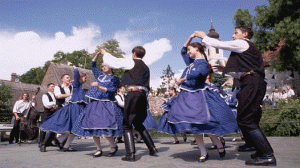
Hungarian is spoken by 12 million people in Hungary, Romania, and Yugoslavia and is a member of the Finno-Ugric family of languages. The Hungarians call their language Magyar. Over half of the population lives in cities, of which the largest is the capital – Budapest. Here more than 2 million people live and make up over 20 percent of the country’s total population. Some of Hungary’s smaller cities include Miskolc, Debrecen, Szeged, and Pecs.

The site now occupied by Budapest has been inhabited at least since Roman times, when the settlement was known as Aquincum. Budapest, the capital of the Republic of Hungary, actually consists of two cities that were united in 1873: Buda, built on three hills and overlooking the west bank of the Danube River; and Pest, located on the east bank. Buda is the older part of the city. Budapest is the artistic, cultural and scientific center of Hungary.

The Parliament Building on the bank of the Danube houses the offices of the Prime Minister and all other ministers, as well as the parliamentary library (and, of course, the Deputy Council Chamber where the legislature sits). Construction of the building began in 1880 and ended in 1902. The great hall beneath the dome is 82 feet (27 meters) high.

The different architectural styles of Buda Castle (or the Royal Palace as it is sometimes called) reflects the different historical periods between the 13th and 15th centuries in which construction took place. This inner court of the castle is part of the Renaissance palace built for King Matthias and now serves as the entrance to the Hungarian National Gallery.
